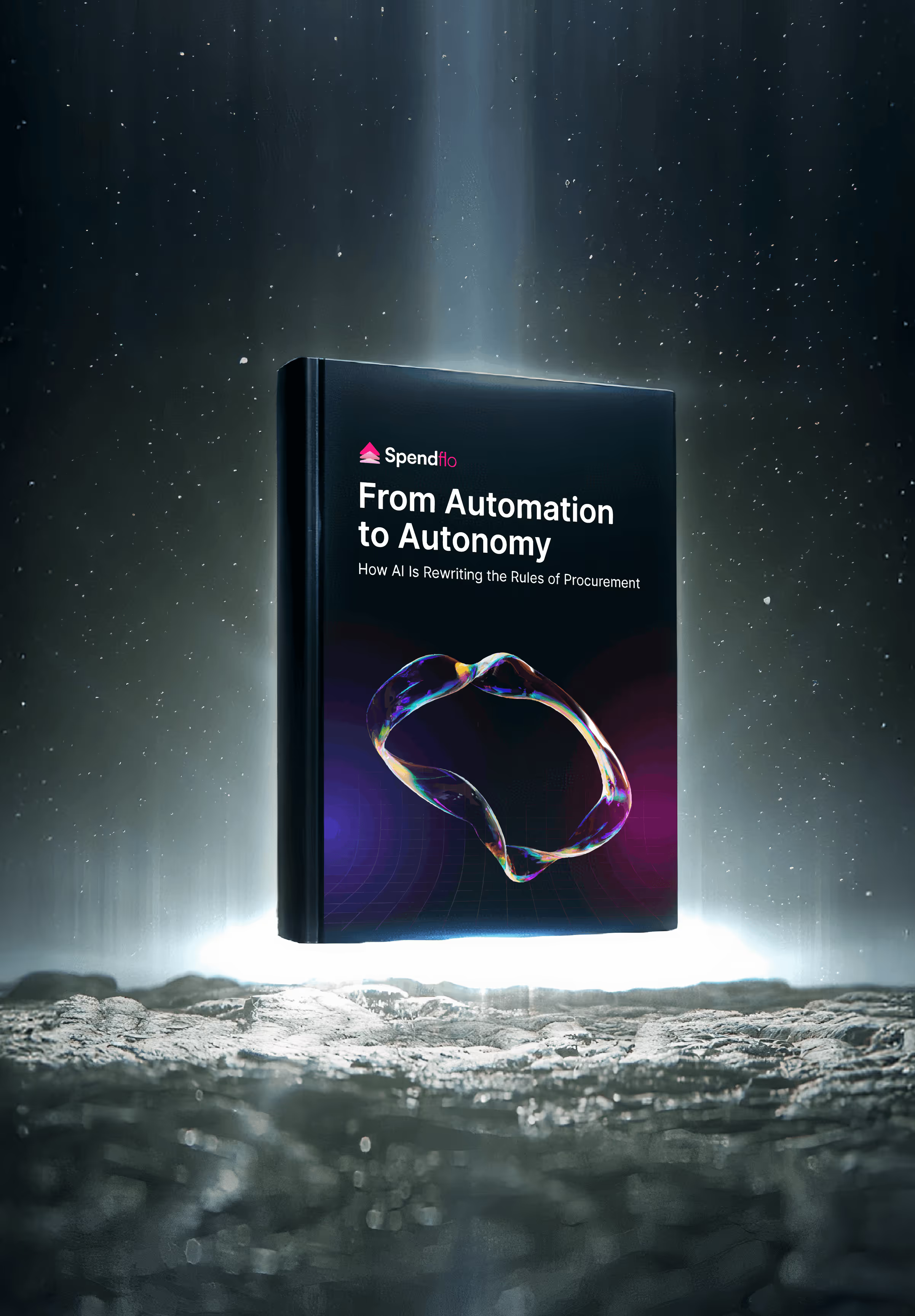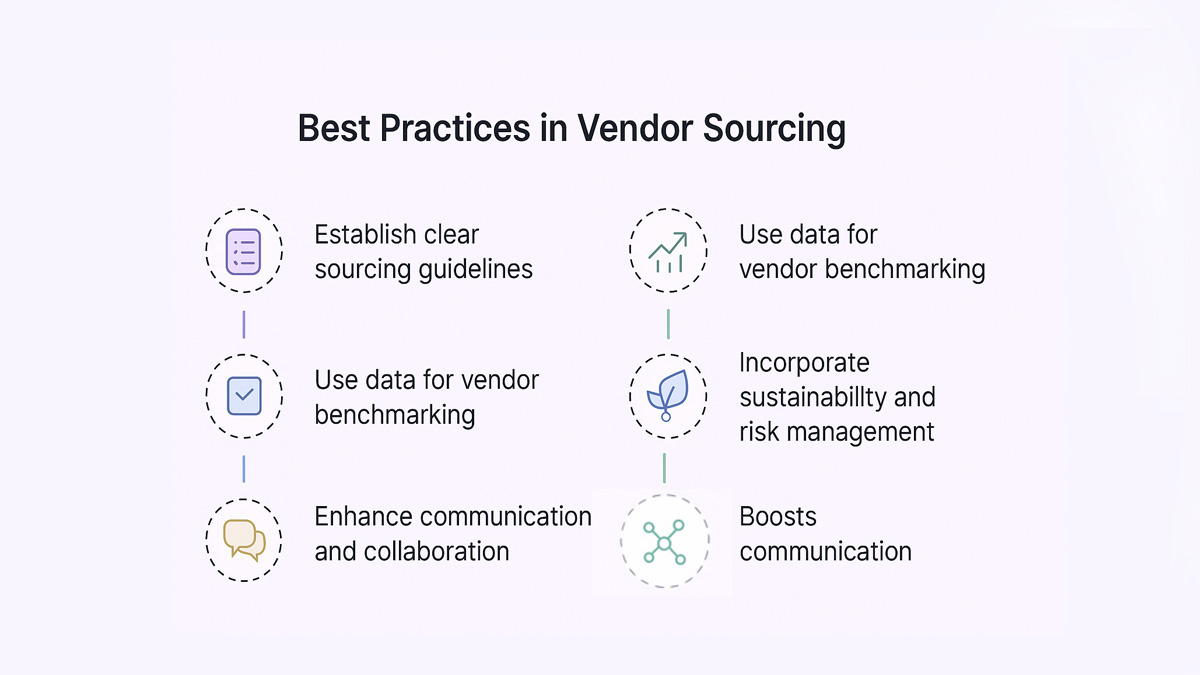

A Complete Guide to Vendor Sourcing

A Complete Guide to Vendor Sourcing
Learn the key steps and strategies for effective vendor sourcing to cut costs, manage risks, and build stronger supplier relationships.


Choosing the right vendors isn’t just about getting the lowest price - it’s about building the kind of relationships that help your business grow, adapt, and thrive. Yet, in an increasingly global and fragmented supply chain, many companies still rely on outdated, reactive sourcing processes. That’s where strategic vendor sourcing comes in - it turns procurement into a competitive advantage.
Done right, it can unlock serious cost savings, boost operational efficiency, and even protect against future disruptions.
What this blog covers:
- What is vendor sourcing?
- Why is vendor sourcing important?
- Types of vendor sourcing
- Steps in the vendor sourcing process
- Best practices in vendor sourcing
- How Spendflo helps with vendor sourcing
- Frequently asked questions on vendor sourcing
What is Vendor Sourcing?
Vendor sourcing is the process of identifying, evaluating, and selecting external suppliers to provide goods or services that meet a company’s needs. It’s a foundational part of procurement that balances cost, quality, reliability, and long-term strategic value.
Why is Vendor Sourcing Important
Vendor sourcing plays a much bigger role than most give it credit for. It’s not just about ticking boxes or sending out RFPs - it’s about shaping how efficiently and resiliently your business operates. It's a critical foundation within the procurement process. A good sourcing strategy doesn’t just lower costs; it enhances agility, builds trust with suppliers, and lays the groundwork for long-term success.

Here’s why vendor sourcing deserves a front-row seat in your procurement strategy:
Supports Cost Efficiency and Savings
When vendor sourcing is done strategically, cost savings come naturally. By evaluating multiple suppliers and negotiating smarter deals, companies can cut excess spend, avoid hidden charges, and even lock in favorable terms. Plus, a competitive sourcing process creates pressure for vendors to offer their best pricing upfront.
Strengthens Vendor Relationships
Sourcing isn't just transactional - it’s relational. Building strong supplier partnerships means better service, more flexibility, vendors to go the extra mile when things get tough. This level of collaboration is a key component of effective vendor management. When trust runs deep, collaboration becomes second nature, leading to innovation and smoother operations.
Improves Supply Chain Resilience
Disruptions are no longer rare - they’re the new normal. Strategic sourcing is now tightly linked to effective supply chain management. Whether it's geopolitical shifts, raw material shortages, or sudden demand spikes, businesses need suppliers they can count on. Strategic sourcing helps diversify your vendor base, reducing dependency on a single supplier and boosting your ability to adapt quickly.
Enables Strategic Decision-Making
Data-driven sourcing gives procurement teams visibility into vendor performance, pricing trends, and contract benchmarks. This turns sourcing from a cost center into a strategic lever. Instead of reacting to procurement becomes proactive and strategic
Types of Vendor Sourcing
There’s no one-size-fits-all approach when it comes to vendor sourcing. What works for a fast-scaling tech startup may not suit a multinational with a complex supply chain. The right strategy depends on your goals - whether it's cost control, agility, risk reduction, or sustainability.
Let’s break down the most common types of vendor sourcing you’ll come across:
Local Sourcing
This involves selecting vendors within the same region or country as your business operations. It’s great for faster delivery times, better communication, and supporting local economies. Local sourcing also helps reduce carbon emissions from transportation - a win for sustainability-conscious organizations.
That said, local options can sometimes be more expensive or limited in scope, especially for specialized goods or services.
Global Sourcing
Global sourcing opens up access to a broader pool of suppliers, often at lower costs due to labor or production efficiencies. Many companies use this approach for large-scale manufacturing or technology procurement. It’s a popular strategy for maximizing cost savings and accessing unique expertise not available domestically.
However, global sourcing comes with challenges - time zone differences, longer lead times,
Near-Sourcing vs. Outsourcing
Near-sourcing is a middle ground - working with vendors in nearby countries (think: a U.S. company sourcing from Mexico instead of China). It strikes a balance between cost savings and logistical simplicity.
Outsourcing, on the other hand, focuses more on shifting non-core functions - like IT support or customer service - to external vendors regardless of geography, with an emphasis on efficiency and cost-cutting.
Single vs. Multiple Sourcing
Single sourcing builds a deep relationship with one trusted vendor - ideal for critical components where quality and consistency matter. But it carries higher risk if that vendor fails to deliver.
Multiple sourcing spreads that risk by engaging several vendors for the same product or service, creating flexibility and backup options.
Steps in the Vendor Sourcing Process
Vendor sourcing isn’t just about picking the cheapest supplier off a list. It’s a structured process - part strategy, part relationship-building - that helps organizations secure the best-fit vendors for their needs. Skipping or rushing these steps often leads to mismatched expectations, inflated costs, and long-term headaches.
Here’s how a thoughtful vendor sourcing process typically unfolds:
Conducting a Market Research
It all starts with understanding the landscape. This involves researching available suppliers, analyzing market rates, and identifying sourcing trends. The goal? To spot qualified vendors, and know what’s possible - and what’s not - before you start shortlisting. It also sets the stage for smoother vendor onboarding.
Creating Sourcing Documentation (RFI, RFP, RFQ)
Next comes the paperwork - but this isn’t just red tape. Requests for Information (RFI), Requests for Proposal (RFP), and Requests for Quotation (RFQ) help standardize how you collect vendor responses. A well-written request for proposal can clarify expectations and streamline vendor evaluation. These documents outline your needs, expectations, and evaluation criteria. The clearer your requirements, the easier it is to compare vendors fairly. Standardizing this step improves the overall vendor management process.
- RFI helps you gather general capabilities.
- RFP invites detailed proposals based on your goals.
- RFQ focuses purely on pricing and commercial terms.
Vendor Evaluation and Shortlisting
Now you dive into the details. This phase involves scoring vendors based on key criteria like cost, technical fit, compliance, reputation, and service levels. Don’t forget to include a risk assessment during this phase. Teams often use scorecards or matrices to objectively compare apples to apples - especially helpful when there are multiple stakeholders involved. A vendor management system can simplify this stage significantly.
Negotiation and Final Selection
Once you’ve shortlisted top contenders, it’s time to negotiate. This leads to issuing a formal purchase requisition to the selected vendor. This goes beyond pricing - think delivery timelines, payment terms, SLAs, and future scalability. The best negotiations are win-win: vendors feel valued, and you lock in terms that support long-term goals.
Best Practices in Vendor Sourcing
Great vendor sourcing doesn’t happen by accident - it’s built on repeatable practices that balance speed, quality, and long-term value. Whether you're scaling your vendor base or tightening your procurement strategy, these best practices can help you get more from every vendor interaction.

Establish Clear Sourcing Guidelines
Clarity is everything. Set clear internal policies that define how sourcing decisions should be made - who gets involved, what criteria matter most, and what compliance standards must be followed. This ensures consistency across departments and avoids ad hoc or emotion-driven decisions.
Think of this as your sourcing “north star.” When teams are aligned on the rules, vendor evaluation becomes faster and far more transparent.
Use Data for Vendor Benchmarking
Don’t rely on gut feeling when better data is just a few clicks away. Benchmarking vendors against industry standards helps you identify whether you’re overpaying or under-served. Procurement software can automate this and bring added accuracy. Consider metrics like cost per unit, delivery timelines, quality scores, and past contract performance.
Regular benchmarking not only sharpens your negotiation edge - it keeps your vendors on their toes and encourages continuous improvement.
Incorporate Sustainability and Risk Management
Today’s sourcing decisions must factor in more than just cost. Environmental, social, and governance (ESG) criteria are becoming standard for responsible sourcing. They're also critical tools for risk mitigation. At the same time, risk management - including financial stability, geopolitical exposure, and supply continuity - is non-negotiable.
Smart sourcing involves looking beyond the quote sheet to assess how vendors align with your long-term values and risk appetite. Ignoring potential vendor risks can result in long-term operational issues.
Enhance Communication and Collaboration
The best vendor relationships don’t start and end with a signed contract. Make space for ongoing dialogue - regular check-ins, feedback loops, and collaborative planning. This proactive approach is the core of vendor relationship management. This creates trust, uncovers hidden opportunities, and helps resolve issues before they spiral.
Good communication isn’t a soft skill here - it’s a strategic asset that pays off in better performance and long-term loyalty.
How Spendflo Helps with Vendor Sourcing
Spendflo simplifies and streamlines vendor sourcing by acting as your dedicated procurement partner. From benchmarking vendor pricing to managing RFPs and negotiating our team ensures you get the best value - without the back-and-forth. We bring visibility, speed, and strategic insight into every sourcing decision. Whether you're consolidating vendors or expanding globally, Spendflo ensures your sourcing process is optimized for savings, compliance, and long-term success.
Frequently Asked Questions on Vendor Sourcing
What is the difference between vendor sourcing and procurement?
Vendor sourcing is a subset of procurement. Sourcing focuses specifically on identifying, evaluating, and selecting suppliers, while procurement includes the broader process - from purchasing and contract management to payment and supplier performance tracking.
How can businesses evaluate vendor performance effectively?
Performance evaluation combines both qualitative and quantitative data. Common metrics include on-time delivery rate, product or service quality, cost adherence, responsiveness, and compliance with contract terms. Regular performance reviews, scorecards, and feedback loops also help ensure accountability and continuous improvement.
What are the risks of poor vendor sourcing?
Rushed or poorly executed vendor sourcing can lead to inflated costs, quality issues, delayed deliveries, and even legal or compliance troubles. A robust vendor risk management plan can help prevent these outcomes. Worse, it can lock you into rigid contracts with underperforming suppliers, making it harder to pivot during disruptions or scale effectively.
How does global sourcing affect supply chain costs?
Global sourcing can reduce unit costs due to labor and manufacturing advantages, but it introduces additional costs - such as logistics, customs, taxes, and risk premiums. While the per-unit cost may be lower, companies must weigh these savings against potential supply chain delays or geopolitical instability.
Why are RFPs and RFQs important in vendor sourcing?
RFPs (Requests for Proposal) and RFQs (Requests for Quotation) standardize how vendors respond to your needs. They ensure you're comparing similar offers, reduce ambiguity, and give suppliers a clear picture of expectations. Well-crafted RFx documents also support better negotiation and help mitigate future misalignment.










.png)




.png)










.avif)





